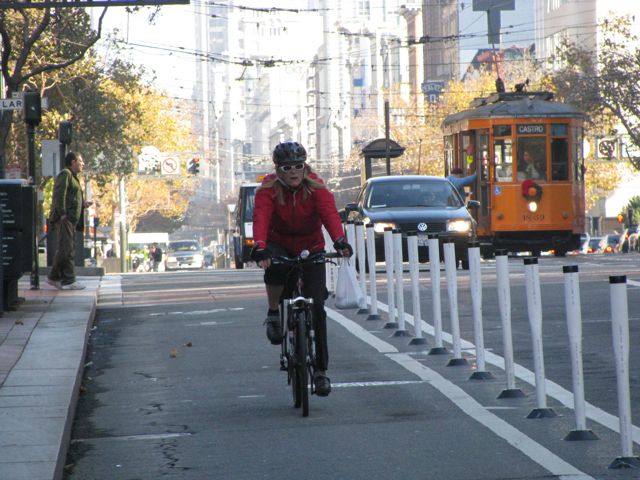Whenever street space is allocated for bicycling, someone will inevitably level the accusation that the city is waging a “war on cars.” But it turns out the people in those cars want separate space for bicycles too, according to surveys conducted in two major California metropolitan areas. Bike lanes make everyone feel safer -- even drivers.

Rebecca Sanders is a doctoral candidate in transportation planning and urban design at the University of California-Berkeley. She’s spent a lot of time asking people -- drivers, cyclists, and pedestrians -- what kinds of street treatments would make them feel safer, giving them a list of safety improvements to choose from. Most drivers said their top priority was bike lanes. (In the Los Angeles area, the top choice was for improved pedestrian crossings, but bike lanes were a close second.)
Sanders began this research with Jill Cooper of Berkeley's Safe Transportation Research and Education Center, under the sponsorship of the state department of transportation (Caltrans). They interviewed drivers, pedestrians, and cyclists on major corridors in and around San Francisco and Los Angeles, asking drivers why they picked the mode they did, and asking everyone how they perceived safety issues, especially for biking. Then they asked what kinds of street treatments would make the street safer for them.
“What was interesting about that study was that in the San Francisco Bay Area, the most requested item, across the board, was a bicycle lane on the corridor,” Sanders told Streetsblog. “It was the most requested item by drivers, it was the most requested item by pedestrians, and it was the most requested item by bicyclists. That was quite surprising to us.”
It’s no shock that cyclists asked for dedicated street space in overwhelming numbers, and it stands to reason that pedestrians want bicycles off the sidewalk. Perhaps it should be just as obvious that drivers would welcome dedicated bike infrastructure, too. They find that bike lanes help them be aware of cyclists and make cyclists’ behavior more predictable, according to Sanders' research. In general, there's less potential for conflict between drivers and cyclists when they each have their own space.
“We have not done a good job of recognizing and validating the concerns of drivers about predictability,” Sanders said. “For a long time, cyclists have been defensive; they’ve been fighting for space, and legitimately so. But in the process, some areas where we could really work together, I think, have fallen to the wayside. Everybody wants predictability on the roadway. Nobody wants to feel like they’re going to get hit or hit someone else and it’s going to be beyond their control.”
The results of Sanders' San Francisco-area research are due to be published soon in the Transportation Research Record and are available now on the Berkeley website. Meanwhile, Sanders has continued to look into drivers' attitudes toward bike lanes, making it the topic of her (as yet unpublished) dissertation. She has conducted focus groups and internet surveys to shed light on what drivers and cyclists need to feel safe.

In her surveys, Sanders distinguished between drivers who also often ride bicycles and those who ride infrequently or not at all. Drivers who bike can better predict other cyclists' actions when they are behind the wheel. But drivers who don’t ride find cyclist behavior erratic and unpredictable, and prefer not to share road space with them. That doesn’t mean they just want cyclists to go away -- many want cyclists to have their own dedicated space, separated from motorized traffic.
Sanders also distinguished between various types of cycling infrastructure. She found that motorists felt most comfortable driving on streets with a higher level of separation between bicycles and cars.
Drivers who don’t bike said they would rather have no treatment at all than sharrows, which they find confusing, while drivers who bike daily would rather have something than nothing, but only narrowly prefer sharrows over nothing at all.
By and large, support grows with increased separation. Drivers prefer protected bike lanes to painted bike lanes, and painted bike lanes to sharrows. And they don't want those bike lanes to be in the door zone of a line of parked cars.
“They would rather drive on a street with just a bicycle lane and no parking than on a street with a bicycle lane and parking,” Sanders said. “Because they know that if someone opens their car door that could send the bicyclist into their lane.”
Of course, drivers have other concerns about removing parking, but they do acknowledge that placing cyclists in the door zone makes bike lanes less effective.
“I don’t claim my study solved that [tension] at all,” Sanders said. “I’m just saying the debate should be broader. When we focus on tradeoffs only, and we talk about taking away parking to put in a bike lane for bicyclists, people perceive it as a war on cars. What we haven’t done is talk about how that also actually benefits drivers, because it improves predictability for them. Which is huge, because everybody wants to be safe.”





